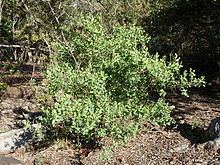Family Euphorbiaceae | Subfamily Acalyphoideae Rank Species | |
 | ||
Similar Clutia, Chionanthus foveolatus, Euclea crispa, Searsia pyroides, Brachylaena discolor | ||
The lightning bush, Clutia pulchella, is a southern African dioecious shrub of the family Euphorbiaceae. It occurs at middle altitudes in Namibia, Mozambique, Zimbabwe, Swaziland, Botswana, Lesotho and South Africa.
Contents
Description
They may grow 2–3 metres (6.6–9.8 ft) high, and occur on a variety of broken terrain types.
The twigs are green with some wart-like growths. Leaf shape is somewhat variable, either blunt-tipped ovate or broadly lanceolate. The foliage is bluish-green but sometimes interspersed with some bright orange leaves. They are soft with venation that is transparent against light, besides the numerous glands that dot each leaf.
The axillary flowers develop into spherical, clearly three-chambered capsules. The capsules are about 3 millimetres (0.12 in) in diameter, and may bear warts. Seeds are released when the dry capsules burst open.
It is a food plant for the Heidelberg copper butterfly. It is similar to the related monoecious species C. abyssinica, which has the leaves more elongated.
